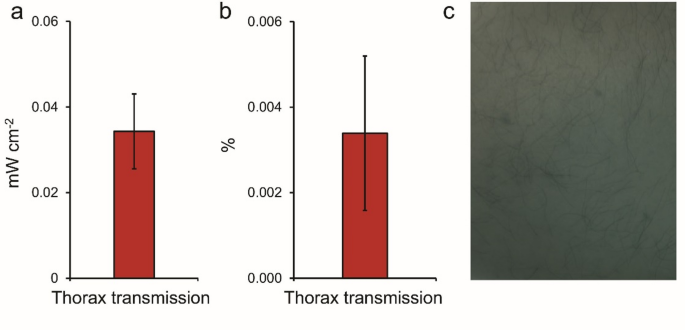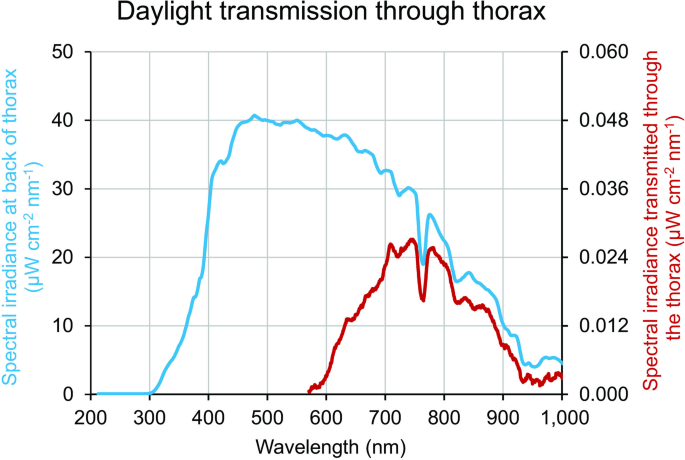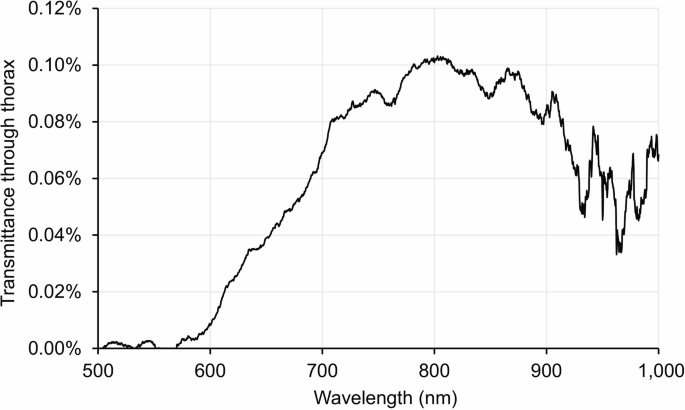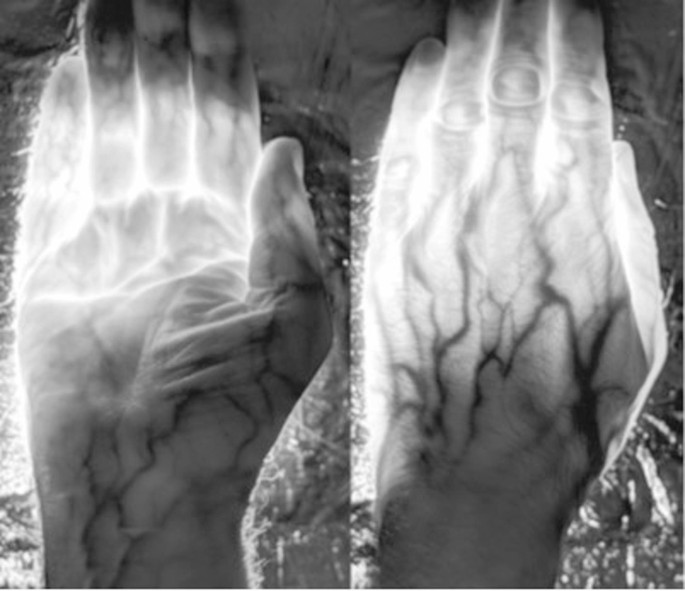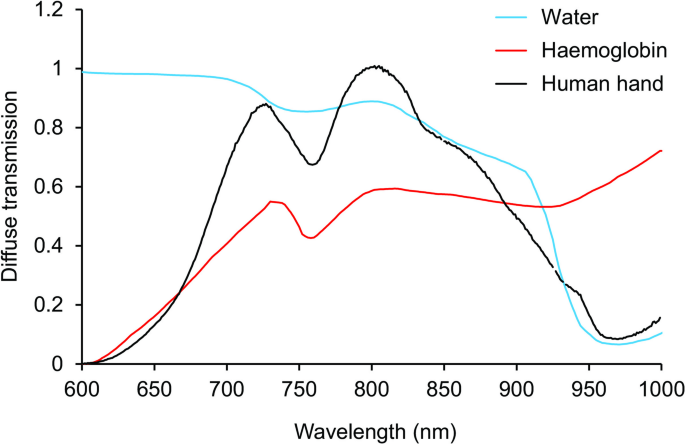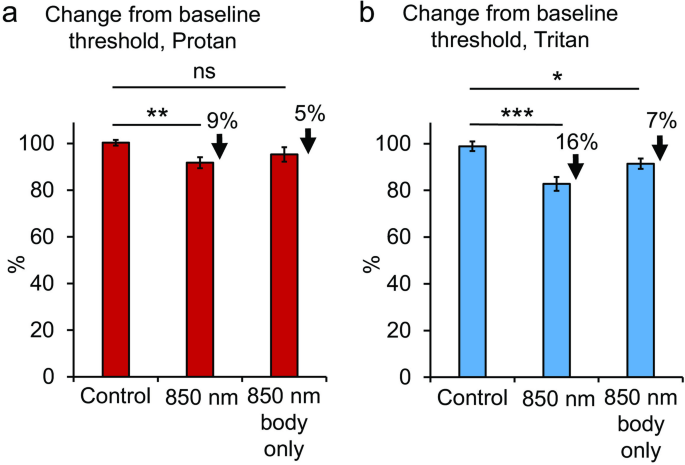- Article
- Open access
- Published: 08 July 2025
Scientific Reports volume 15, Article number: 24435 (2025) Cite this article
-
119k Accesses
-
1033 Altmetric
Abstract
Long wavelength red light that can extend beyond the human visual range penetrates deeply through biological tissue. Exposure to these longer wavelengths improves mitochondrial function and ATP production. This can translate to improved physiological performance, particularly in the CNS, including the visual system. Light driven metabolic improvements to regional exposure can impact systemically. Here we show that infrared wavelengths from sunlight can be measured after they pass through the human thorax. We then select a prominent transmitted solar wavelength range (830–860 nm) and deliver this to the thorax of subjects in the lab in controlled 15 min exposures with and without ocular involvement. Clothing reduced wavelength intensity but was not a barrier. These exposures were associated with significantly improved visual function when measured 24 h later even in subjects in which light was blocked from the eyes. Our data show that longer wavelengths of sunlight penetrate through the human body and, consistent with animal studies, have the ability to improve function. While infrared light has been used on targeted tissues, its ability to improve distal tissues in humans has not been explored. This study also highlights the potentially important therapeutic value of sunlight whose longer wavelengths can reach key organs even through clothing and likely promote mitochondrial function counteracting the decline with age and disease.
Similar content being viewed by others
Introduction
The sunlight spectrum at ground level ranges from approximately 300 nm – >3000 nm and has been a stable influence on life across evolution, providing the energy to drive evolutionary change. Its composite wavelengths play separate roles in physiological regulation by influencing mitochondria that are key agents in metabolism and ageing. Mitochondria produce ATP, often referred to as the cellular currency of cells in terms of energy production. They have a membrane potential that declines with age and disease resulting in reduced ATP production. This decline is commonly associated with increased reactive oxygen species (ROS) that drives inflammation and can result in cell death and the decline of the organism. This forms the core of the mitochondrial theory of ageing1.
Mitochondria are light sensitive. Longer wavelengths (approximately 660–1000 nm) increase mitochondrial membrane potential and ATP production particularly when they have declined with age or disease and can improve performance2,3,4,5,6,7. This is possibly in part due to their absorption by the copper heme in cytochrome c oxidase8 although absorption patterns influencing physiology are likely to be more complex than this alone. Shorter wavelengths (400–450 nm) have the opposite effect, most probably being absorbed by in the Soret band of a porphyrin, resulting in ROS production and reducing mitochondrial function and performance9. The differential impact of these spectral regions is highly conserved across species but they do not have hard borders. In sunlight these long and short spectral components have a stable balance present in daylight across evolution.
The outer retina contains more mitochondria than any other tissue, with a high metabolic rate and a concomitant rapid pace of ageing10. Consistent with this, in human subjects, long wavelength application results in improved visual function7. It also can reduce blood sugars, as increasing mitochondrial function and ATP production requires elevated demand for serum carbohydrates11. This is an example of systemic impact because only small regions of the body are exposed to significantly reduce blood sugars. Likewise, improved CNS performance can be obtained when distal regions of the body are exposed12,13. This systemic influence may be mediated by cytokine signalling as the complex array of serum cytokines shifts significantly following regional long wavelength light exposure14.
Many experiments using longer wavelengths have concentrated on 670 nm which is visible red light. Here we ask if longer wavelengths present in sunlight and that are beyond our visual range that extends approximately between 400 and 700 nm can penetrate deeply through the human body and influence visual function with and without ocular involvement.
Methods
Experiments were undertaken on 40 Caucasian subjects of both sexes between the ages of 25 to 63 under ethical approval from City St George’s, University of London (ETH2324-0250) and complied with the code of ethics of the world medical association (Declaration of Helsinki). Informed consent was obtained from all subjects. A series of laboratory experiments were undertaken and measurement made of light and its penetrance in the open environment. They were either drawn from the academic community or from those from the commercial lighting, design and architecture community. The experiments measured sunlight and LED light penetrance through the human thorax and hand and its impact on visual function. They also assessed differing light wavelength penetration on clothing.
Sunlight
Male subjects (N = 7. Mean age 37 ± 17) stood with their backs facing clear sunlight in mid-June, with no clothing from the waist up. A metal box 15 cm square and 30 cm long made from 1 mm thick aluminium sheeting was placed against their chest. This was used to house probes from either a spectrometer (Ocean Optics QE65 ) or a radiometer (Interlight ILT5000 Research Radiometer) to measure the wavelength/energy of sunlight passing through the body. With measuring probes placed against the subjects chest the rear opening of the box was packed with aluminium foil to block stray light. Three independent measurements were made of light passing through the thorax with each device over a period of approximately 3 min. These data provided the energy of light passing through the thorax and its spectral profile. Additionally, an infrared sensitive camera was used to image the light and directly visualise its transmission through the thorax. As a control for the identification of potential light absorbers, a separate experiment was undertaken. First, a human hand was imaged over an 850 nm LED source with an infrared sensitive camera to confirm that this wavelength range penetrated the tissue. This was in a male subject aged 75 years. This tissue was approximately 3 cm thick. This wavelength range was used because it was a dominant feature of light passing through the thorax. Second, the spectrum of light through the hand was analysed from a continuum source of a tungsten filament light via an integration sphere. These data were mapped against the known absorbance profiles of water and haemoglobin to determine their contributions to absorbance across the hand.
LED 850 nm light
Light penetrance was also measured through the thorax from an 850 nm light source in the form of a standard 60 cm X 60 cm ceiling panel containing an array of 3024 850 nm LEDs equally spaced across it giving an energy of 9.18mW/cm2 at 50 cm, which was the distance at which subjects were exposed and measurements of transmission made. This was manufactured to our specifications by Light, Power Health UK. 850 nm LEDs had a half power band width of 830 nm and 865 nm in a slightly positively skewed asymmetric distribution. This LED was chosen because its range approximated that of a prominent spectral range of sun light measured passing through the thorax. Measurements of LED light transmission were made in a dark laboratory. In a separate group of subjects, (N = 8. Mean age 46 ± 15) the transmission of light through the thorax from the 850 nm panel was measured in a manner similar to the daylight experiments in a darkened room. The 850 nm light could not be seen with the eye unless the subject was close to it and could not be seen at the distance used for exposure in the room. A further group 13 subjects (8 male, 5 female. Mean age 48 ± 20) were also exposed to the panel with the purpose of assessing this exposure on visual function (850 nm group). These data were compared against a further 5 subjects (Male. Mean age 36 ± 9) who had their head wrapped in aluminium foil to differentiate between eye mediated, and body surface mediated effects (850 nm body only group). Additionally, 7 control subjects (Female. Mean age 35 ± 8) were placed in the same position in the room but the 850 nm panels was not turned on, as a sham exposure (Control group). A trial for each subject, consisted of a first visit during which baseline colour contrasts thresholds were measured. Immediately following this, participants were exposed to the 850 nm light or a sham exposure (control) for 15 min at 9 mW/cm2. Exposure was to their back with no clothing on their upper body, in a dark room. 24 h later the participants returned, and their colour contrast thresholds were measured a second time.
The assessment of visual function was based on colour contrast detection thresholds. Colour contrast was chosen because with age cone photoreceptors have reduced function mainly due to mitochondrial decline7. However, these cells rarely die, making them idea for optical manipulation to improve mitochondrial performance. Each subject had their colour contras measured psychophysically using Chroma test7. This is a computer graphics system, where letters of varied contrast are presented binocularly on a high-resolution NEC Spectraview monitor on an isoluminant background at a distance of 1.5 m in a dark room, exactly as employed by Shinhmar et al.7. Shinhmar et al. provided the end point X, Y coordinates defining the protan and tritan axis according to the CIE colour space in their Table 2, which were identical to those used here. If subjects correctly identified the presented letter, the contrast in the colour domain was reduced. If subjects incorrectly identified the letter the contrast was increased. This was repeated in multiple tests until detection threshold was determined.
On each trail tritan and protan presentations were interleaved sequentially. Room illumination was approximately 3 lx. Each subject was given a familiarisation trial and then tested on 5 consecutive trials. In each trial approximately 30 letters were presented giving approximately 100–120 test trails per subject. Outcome data are given as thresholds in percentage contrast detection for protan and tritan domains. Because infrared wavelengths can be reflected from surfaces and also penetrate eye lids when closed, 5 subjects had their heads wrapped in aluminium foil to completely block light from the eye during light exposure. 24 h later subjects returned and were retested for colour contrast.
In sunlight and 850 nm LED light subjects were not wearing upper clothing and it is unclear if clothing modifies long wavelength light. Hence, we measured qualitatively the transmission of visible and 850 nm though clothes comprising layered fabrics. This was determined using a camera (a modified Sony α7R with full UV - IR response with appropriate visible and NIR-pass > 760 nm filters) sensitive to both the human visual range and NIR light. The clothing consisted of two sets of three layers: a knitted wool and two layers of polyester/polyamide fabric (a shirt and a T-shirt).
Results
Sunlight transmission through the body
Subjects were exposed to direct sunlight around midday and measurements made of light transmission through the chest were made by placing a radiometer on their chest within an aluminium light tight box shield. In each of the subjects tested, exposure of the body surface to direct sunlight resulted in long wavelength light detection on the other side of the body. This is shown in Fig. 1. Figure 1a shows the absolute measurement of light through the thorax, Fig. 1b shows the percentage of light passing through and Fig. 1c, is an infra-red image of the light captured after its passage through the thorax. Hence, the body showed a degree of transparency to sunlight.
(a) Sunlight transmission through the thorax given as a percentage of sunlight (b), also in absolute values. (c). as imaged with a sensitive IR camera against the body. In all subjects sunlight could be measured following transmission through the thorax. Measurements were made between approximately 11am and 1pm in direct sunlight. The radiometer used to measure the energy was embedded in an aluminium box packed with aluminium foil to block stray light. A photograph from an infra-red sensitive camera showing the transmitted light is to the right. This was taken with a 10 s exposure, aperture f/8, speed ISO 100 and a focal length of 20 mm.
An example of the spectrum of light transmitted through the thorax is shown in Fig. 2. The blue line is the spectrum of direct sunlight on the day in which transmission was measured. The measured sunlight spectrum ranges from approximately 300 nm to approximately 1000 nm. The transmitted light through the thorax is much reduced compared to direct sunlight and is longwave wavelength shifted spanning approximately 600 nm to approximately 1000 nm. Note the different scaling on the left and right Y axes that have been used so that both spectra can be presented together.
Body transmission of sunlight in a representative individual. Blue line is the spectrum of sunlight present during measurements of light through the thorax. Sunlight ranged from approximately 300 nm to > 1000 nm. The power of the light is given on the left Y axis. Red line is the spectrum of direct sunlight passing through the thorax was measured. This showed a mark long wavelength shift between approximately 600 nm to > 1000 nm. The energy of light passing through the thorax was very reduced and is given on the right-hand Y. The very low level of sunlight detected passing through the body is consistent with a large percentage of light being absorbed/scattered by the body.
In Fig. 3 the ratio of transmitted light to the sunlight spectrum is shown. This results in a peak in the region of 800 nm to approximately 870 nm. At 850 nm sunlight has a strength of approximately 17mW/cm2, while that measured after transmission through the chest had an average of approximately 5.6µW/cm2.
This curve is a ratio of the spectral irradiance through the thorax, relative to the spectral irradiance of daylight falling onto the thorax. This therefore provides an indication of which wavelengths are absorbed most strongly by the body, and which pass through. Note that the incident daylight is highly directional whereas the transmitted light is scattered in all directions; the small magnitude of the transmitted irradiance is due to it being spread over a larger area. There is very little transmission below 600 nm, with transmission increasing up to a peak in the range 800–875 nm. Instability above 930 nm is due to instrumentation.
These results show that sunlight is transmitted through the body, but they likely suffer from a degree of noise as it is difficult to measure key metrics in environmental conditions lacking tight laboratory controls. Hence, two additional experiments were undertaken in laboratory conditions in darkness. The first used a thermal continuum source on the hand with the aim of identifying key absorbers around 850 nm in this thinner tissue that was approximately 3 cm thick. The second used a large LED panel source illuminating at a peak of 850 nm with half-power bandwidth of approximately 35 nm, which includes the range of the peak ratio shown in Fig. 2. This was undertaken to determine the impact of longer wavelengths found in sunlight on visual function.
Figure 4 shows the transmission of light passing through the hand using an infrared sensitive camera. The tissue is very transmissive with only deoxygenated blood showing a degree of absorbance as the veins are clearly visible in black. Bones in the hand show no indication of absorbance. The spectrum of light passing through the hand is shown in Fig. 5.
Light transmission through the hand from an 850 nm LED source. Because the tissues are relatively thin compared with the thorax it was possible to map the spectrum here against known biological absorbers. The images clearly show that deoxygenated blood is a key absorber. Also, bone can not be seen and hence is relatively transparent at these longer wavelengths.
Spectral transmission of a daylight type source through the hand from a tungsten filament via an integrating sphere. The diffuse transmittance spectrum through the mid-palm of the human hand normalised to a peak of unity. The principal absorbers are haemoglobin at shorter, and water at longer wavelengths. This was measured with a Maya2000Pro spectrometer using an ISP-REF integrating sphere as a tungsten filament light source and a 500 μm diameter optical fibre (all from OceanInsight) to collect the transmitted light.
The overall profile, shown in black, is similar to that seen in Fig. 2 for thorax transmission and covers a very similar spectral range. Outlined on the absorption profile are two principal absorbers, water in blue and haemoglobin in red. Water and haemoglobin both contribute to the dip seen around 750 nm. Water absorbance is a key contributor to the gradual decline seen from around 820 nm onwards. Other weak absorbers most likely contribute to the detailed spectral shape.
Light in the 850 nm range that is found in sunlight shows a clear ability to penetrate deeply through the body and it is likely that such wavelengths improve mitochondrial function that likely impacts on physiological ability. We measured the light transmission of the thorax to the 850 nm panel in otherwise dark conditions. This is shown in Fig. 6. Figure 6a shows the absolute transmission while 6b shows the percentage transmission. An infrared image like that shown in Fig. 1c could not be obtained because there was not enough light. Hence, light from the 850 nm panel was transmitted through the body, as observed in sun light although at a lower energy level. Because the energy was low it was not possible to reliably plot its spectrum. However, we did explore the consequences of its transmission.
Light transmission through the chest from an 850 nm LED panel in laboratory controlled dark conditions. (a) shows the absolute light level and (b) the percentage. The proportion of this wavelength penetrating the body is similar to that in sunlight, but the absolute levels is much lower than sunlight. It was not possible to capture and infrared image or to plot the spectrum of transmitted light because the energy levels were so low.
To assess this, we examined colour contrast detection thresholds in subjects exposed to the 850 nm panel. Previously we have used this sensitive metric to reveal improved human colour visual function following exposure to 670 nm light7. This psychophysical method was used in subjects exposed to the 850 nm in laboratory conditions to detect changes in visual thresholds along the both tritan (blue-yellow) and the protan (red-green) visual axis. 850 nm light was initially directed at subjects backs from 1.5 m with their eyes closed for 15 min. However, we noted that radiometric measurements of reflected light from walls and other surfaces from the light generated by the 850 nm panel were high and multidirectional. Hence, a subgroup had their heads wrapped in aluminium foil to block ocular exposure arising from reflections.
Figure 7 shows colour contrast threshold measurements made for protan and tritan. Thresholds for protan contrast sensitivity were reduced by a significant 9% (p = 0.0053) following 850 nm exposure to the back. Although they were also reduced when the head was shielded from the light, this was not significant (p = 0.1856). Thresholds for tritan are more sensitive than protan to long wavelength exposure, with relatively larger improvements following exposures as shown in previous studies using 670 nm7. Thresholds for tritan following 850 nm exposure were reduced by a significant 16% (p = 0.0003) with exposure to the back and by a significant 7% (p = 0.0351) when the head was shielded. These data confirm that light exposure to the body can improve visual function independent of ocular input, but to different degrees. With the head shielded the consequences of exposure must have been mediated by light transmitted through other regions of the body.
Colour contrast measurements made for protan (red) and tritan (blue) contrast sensitivities. (a)Thresholds for Protan contrast sensitivity were reduced by a significant 9% following 850 nm exposure to the back but although reduced when the head was shielded from the light this was not significant (body group only). (b) Thresholds for tritan are more long wavelength sensitive than protan. Thresholds here were reduced by a significant 16% with 850 nm exposure to the back and by a significant 7% when the head was shielded (body group only). These data confirm that light exposure to the body can improve visual function independent of ocular input. Abbreviations: ns, not significant. Statistical symbols * p < 0.05. ** p < 0.01. *** p < 0.001.
This study shows that longer wavelengths present in sunlight penetrate the body and can be measured after they pass through. Further, that these have the ability to improve visual function independent of ocular involvement. A natural question to arise is how this transparency changes with clothing and to what extent does clothing act as a barrier. As types of clothing vary widely depending on fabric type and weave, the question cannot realistically be answered quantitatively. However, Fig. 8 shows three images of the same common clothing items combined including a T-shirt, a shirt and a woollen jumper (6-layers in total) taken with a camera that has both normal and infra-red sensitivity. The first is taken in normal reflected light, the second with a light source in the human visual range behind the items and the third in infrared mode, with an 850 nm light source behind. The clothing shows a marked transparency to the 850 nm light source. Hence, clothing is unlikely to be a barrier to long wavelength penetration of the body and any subsequent functional improvements that may occur because of it.
The transmission of light through clothing. Images were captured with a camera whose sensitivity covered the visual and infra-red range. Each panel contains an image of light transmission through a T-shirt, a shirt and a woolen jumper on a hanger. Left: image in ambient daylight; Middle: image backlit with an LED lamp both photographed in visible only light; Right: the same as the middle image but taken with an infrared (750–1000 nm) camera passing only the 850 nm light from a 54 W 660/850nm Candeer red light therapy LED lamp. This shows that the clothes (six layers in all) are nearly 100 times more transparent at 850 nm than in the visible. The answer is the NIR light penetrates normal indoor clothing quite effectively.
Discussion
This study shows that longer wavelengths in sunlight are transmitted through the body. When these are presented via NIR LEDs in a laboratory-controlled environment at much lower energies, they again have the ability to be transmitted through the body and also are associated with improved visual function independent of ocular exposure. Hence, body penetration by longer wavelengths impacts systemically. Longer wavelengths improve mitochondrial membrane potential and ATP production and improve function in a species conserved pattern that can impact on mobility, visual function and cognition, particularly in ageing2,3,4,6,7. In short lived animals they can extend average life span15.
Taken together, these data provide evidence of the importance of the full spectrum of sunlight for human health. They also highlight the potential dangers of the restricted spectra found in white LED lighting in the modern built environment that lacks longer wavelengths and whose output is generally restricted to around 400–650 nm. The absence of longer wavelengths from LED light sources may have implications for public health that should be addressed16.
This study is not the first to measure light penetrance through the human body, as Hart and Fitgerald17 made measurements in postmortem tissues. Our results generally agree with theirs, but none of their measurements were undertaken in sunlight and clearly none could be matched against psychophysical function.
The results on improved visual function with 850 nm are consistent with other studies that have used LED-based longer wavelengths to improve mitochondrial performance, particularly 670 nm, for which there are numerous studies7. But we note in data not reported here that 670 nm does not transmit across the human body, which is consistent with relatively shorter wavelengths having reduced biological penetrance. The increasing strength of water absorbance bands towards wavelengths longer than 900 nm (see Fig. 4) implies that only restricted spectral regions will allow penetrance above 1000 nm. In terms of overall outcome on visual function, there is little obvious difference between 670 nm and 850 nm, although they have not been tested under identical conditions. We do not know the relative merits of wavelengths between 670 nm and 900 nm, which remains to be explored.
It is known that improving mitochondrial function by illumination at a specific location results in distal as well as proximal effects. This is called the abscopal effect. It was noted scientifically by Durieux et al. who commented using C elegans “we find that mitochondrial perturbation in one tissue is perceived and acted upon by the mitochondrial stress response pathway in a distal tissue”18. Clinically it is recognised that targeted irradiation of a primary tumour can result in shrinkage of secondary tumours in distal tissues19. Such patterns are present in many reports using longer wavelengths to improve mitochondrial function, and they show that it triggers a widely communicated response13,20,21. A key example of this is the exposure of 670 nm light to a limited skin region that results in a significant reduction in challenged blood sugars11. The authors argue that this arises from increased carbohydrate demand from stimulated mitochondria. But the size of the effect can only arise if mitochondria in a much wider region than illuminated are upregulated and increase demand for blood sugars.
The route of the abscopal effect is unclear. However, 670 nm irradiation in mice results in changes in patterns of serum cytokine expression that may be part of the pathway for systemic effects14 If correct, then depth of light penetration arising from longer wavelengths may not be a significant variable because all that is needed is a triggering effect on targeted tissues including the skin, although the energy, wavelength and time of day regulating this are unknown. Improved human vision with 670 nm light can be obtained with only 3 min exposure within 3 h of application7. In insect experiments where greater numbers can be used, there is a clear tiggering effect in exposure times at around 1 min, with no evidence for a dose response function22,23. Given the highly conserved nature of long wavelength exposure on mitochondrial performance, one might expect the same in human experiments. Understanding the limits of these variables are of importance in understanding needs for human health.
Of equal importance is the identification of the absorbers of these wavelengths and their mode of action in improving physiological function. There have been no systematic attempts to define an action spectrum for the effect of the NIR light at different wavelengths. Hence, in spite of its relatively shallow body penetration, use of 670 nm remains common although it is limited because it can dominate the visual environment. We have noted some of the absorbers at 850 nm but there is still no clear understanding of the complexities of infra-red absorption. Hence, we should consider the possibility of many weak absorbers at different wavelengths combining to influence the interactions between biomolecules, especially those comprising the mitochondrial Electron Transport Chain (ETC).
Individual NIR photons at wavelengths near the maximum of body transmission carry about forty times the kinetic energy of a biomolecule at body temperature (~ 310 K). On absorption, these photons can accelerate redox reaction rates in the ETC and so increase ATP production. By adding the extra energy as a radiative excitation to a low-lying electronic or vibrational state rather than heat, this process operates without an excessive increase in tissue temperature. Such NIR-accelerated processes are well-known as ‘Green Chemistry’ in chemical production24 but we propose that they may be important for mitochondrial function in living tissues.
Such a picture would be seen as a real-time effect limited to the period when the NIR photons were available. There is evidence however that short periods of illumination have a lasting effect on mitochondrial function extending for multiple days following the dose7,15. This suggests that the NIR is generating a long-lasting photocatalyst. This has not been identified but could be associated with the orchestration of the mechanisms that control the balance of ROS and antioxidants that maintain full mitochondrial function25.
In spite of the potential parallels that can be drawn between sunlight and selective exposure to long wavelength ranges, there are numerous key differences. Both may have the ability to influence blood glucose levels, but sunlight has a continuous spectrum and is present for extended periods, while experimental long wavelength delivery has a reduced spectral range and is often delivered at relatively high energy and for short periods. Hence, it is possible that 670 nm and 850 nm exposure release a transitory mechanism that is permanently expressed in sunlight but at a lower more constant level.
The shift from sunlight to leds in the built environment
There has been a major change in the human experience of light since the introduction of LED lighting in the early twenty first century. While evolution has taken place under sunlight, the human experience is now very different. The move to a built environment has taken humans away from their evolutionary history in terms of reducing sunlight exposure, but this was initially mitigated by two issues. Both fire light and light from older incandescent lighting have significant longer wavelength components and hence similarities to solar light. This is not the case for standard LED lighting used in buildings that has come to dominate over the last 20 years. In white LED lighting whether warm or cool there are few if any wavelengths over 650 nm and the dominant wavelength is blue at approximately 450 nm: 420–450 nm is known to undermine mitochondrial function, particularly in the absence of IR9,26,27. Such wavelengths are intense in lighting units with colour temperature of 4000–5000 K. These wavelengths not only undermine mitochondrial performance, but also have an immediate effect significantly increasing human heart rate and significantly reducing blood pressure28. This is most likely mediated by surface skin absorbance. Hence, as with NIR used to control blood sugars11skin absorbance may be key to some critical physiological processes that do not need deep light penetrance. These factors are largely overlooked but may raise issues of concern for public health.
Data availability
The data sets used are and/or analysed during the current study are available from the corresponding author on reasonable request.
References
Lopez-Otin, C., Blasco, M. A., Partridge, L., Serrano, M. & Kroemer, G. The hallmarks of aging. Cell (2013). https://pmc.ncbi.nlm.nih.gov/articles/PMC3836174/.
Gkotsi, D. et al. Recharging mitochondrial batteries in old eyes. Near infra-red increases ATP. Exp. Eye Res. 122, 50–53 (2014).
Calaza, K., Hoh Kam, J., Hogg, C. & Jeffery, G. Mitochondrial decline precedes phenotype development in the complement factor H mouse model of retinal degeneration but can be corrected by near infrared light. Neurobiol. Aging 36, 2869–2876 (2015).
Kokkinopoulos, K., Coman, A., Hogg, C., Heckenlively, J. & Jeffery, G. Age-related retinal inflammation is reduced by 670 Nm light via increased mitochondrial membrane potential. Neurobiol. Aging 34, 602–609 (2013).
Xie, K., Khoury, H., Mitrofanis, J. & Aurstin, P. A systematic review of the effect of photobiomodulation on the neuroinflammatory response in animal models of neurodegenerative diseases. Rev. Neurosci. https://doi.org/10.1515/revneuro-2022-0109 (2022).
Weinrich, T., Coyne, T., Salt, T., Hogg, C. & Jeffery, G. Improving mitochondrial function significantly reduces metabolic, visual, motor and cognitive decline in aged Drosophila melanogaster. Neurbiol. Aging. https://doi.org/10.1016/j.neurobiolaging.2017.08.016 (2017).
Shinhmar, H., Hogg, G., Neveu, M. & Jeffery, G. Weeklong improved colour contrasts sensitivity after single 670 Nm exposures associated with enhanced mitochondrial function. Sci. Rep. https://doi.org/10.1038/s41598-021-02311-1 (2021).
Karu, T., Pyatibrat, L. & Afanasyeva, N. A novel mitochondrial signalling pathway activated by visible-to-near infrared radiation. Photochem. Photobiol. https://doi.org/10.1111/j.1751-1097.2004.tb00097.x (2007).
Hoh Kam, J., Hogg, G., Fosbury, R., Shinhmar, H. & Jeffery, G. Mitochondria are specifically vulnerable to 420nm light in drosophila which undermines their function and is associated with reduced fly mobility. PlosOne. https://doi.org/10.1371/journal.pone.0257149 (2021).
Campello, L. et al. Aging of the retina: molecular and metabolic turbulences and potential interventions. Annu. Rev. Vis. Sci. https://doi.org/10.1146/annurev-vision-100419-114940 (2021).
Powner, M. & Jeffery, G. Light stimulation of mitochondria reduces blood glucose levels. J. Biophotonics. https://doi.org/10.1002/jbio.202300521 (2024).
Johnstone, D. et al. Indirect application of near infrared light induces neuroprotection in a mouse model of parkinsonism - an abscopal neuroprotective effect. Neuroscience. https://doi.org/10.1016/j.neuroscience.2014.05.023 (2014).
Gordon, L. et al. Remote photobiomodulation targeted at the abdomen or legs provides effective neuroprotection against parkinsonian MPTP insult. Eur. J. Neurosci. https://doi.org/10.1111/ejn.15973 (2023).
Shinhmar, H., Hogg, G. & Jeffery, G. Exposure to long wavelength light that improves aged mitochondrial function shifts acute cytokine expression in serum and the retina. PlosOne Doi. https://doi.org/10.1371/journal.pone.0284172 (2023).
Powner, B., Slat, T., Hogg, C. & Jeffery, G. Improving mitochondrial function protects bumblebees from neonicotinoid pesticides. PlosOne Doi. https://doi.org/10.1371/journal.pone.0166531 (2016).
Ratto, G., Videla, F. & Marinez Valdiviezd, J. Artificial light: traditional and new sources, their potential impact on health and coping strategies: preliminary spectral analysis. In Proc. SPIE 11814, Current Developments in Lens Design and Optical Engineering XXII, 118140O (1 August 2021) (2021). https://doi.org/10.1117/12.2593623.
Hart, N. & Fitzgerald, M. A new perspective on delivery of red-near-infrared light therapy for disorders of the brain. Discov Med (2016). https://pubmed.ncbi.nlm.nih.gov/27755969/.
Durieux, J., Wolff, S. & Dillin, A. The cell-non-autonomous nature of electron transport chain-mediated longevity. Cell (2011). https://www.cell.com/fulltext/S0092-8674(10)01434-0.
Wang, X., Zhang, H., Zhang, X. & Liu, Y. Abscopal effect: from a rare phenomenon to a new frontier in cancer therapy. Biomark. Res. (2024). https://pubmed.ncbi.nlm.nih.gov/39228005/.
Johnstone, D. et al. Indirect application of near infrared light induces neuroprotection in a mouse model of parkinsonism - an abscopal neuroprotective effect. Neurorscience https://doi.org/10.1016/j.neuroscience.2014.05.023 (2014).
Saliba, A. et al. Photobiomodulation mitigates Diabetes-Induced retinopathy by direct and indirect mechanisms: evidence from intervention studies in pigmented mice. PlosOne Doi. https://doi.org/10.1371/journal.pone.0139003 (2015).
Weinrich, T., Hogg, C. & Jeffery, G. The Temporal sequence of improved mitochondrial function on the dynamics of respiration, mobility, and cognition in aged Drosophila. Neurobiol. Aging. https://doi.org/10.1016/j.neurobiolaging.2018.06.010 (2018).
Powner, M., Priestley, G., Hogg, G. & Jeffery, G. Improved mitochondrial function corrects immunodeficiency and impaired respiration in neonicotinoid exposed bumblebees. PlosOne (2021). https://pubmed.ncbi.nlm.nih.gov/34437613/.
Escobedo, R., Miranda, R. & Martinez, J. I. Irradiation toward green chemistry, a review. Int. J. Mol. Sci. (2016). https://www.mdpi.com/1422-0067/17/4/453
Tan, D., Reiter, R., Zimmerman, S. & Hardeland, R. Melatonin: both a messenger of darkness and a participant in the cellular actions of Non-Visible solar radiation of near infrared light. Biology https://doi.org/10.3390/biology12010089 (2023).
Powner, M. & Jeffery, G. Systemic glucose levels are modulated by specific wavelengths in the solar light spectrum that shift mitochondrial metabolism. PlosOne. https://doi.org/10.1371/journal.pone.0276937 (2022).
Kaynezhad, P. et al. Near infrared spectroscopy reveals instability in retinal mitochondrial metabolism and haemodynamics with blue light exposure at environmental levels. J. Biophoton. https://doi.org/10.1002/jbio.202100283 (1922).
Stern, M. et al. Blue light exposure decreases systolic blood pressure, arterial stiffness, and improves endothelial function in humans. Eur. J. Prev. Cardiol. https://doi.org/10.1177/2047487318800072 (2020).
Acknowledgements
We thank our subjects for their time particularly the lighting engineers at Hoare Lea UK, We also thank Light, Power, Health UK for designing and building the 850 nm light panel used in our experiments.
Ethics declarations
Competing interests
The authors declare no competing interests.
Additional information
Publisher’s note
Springer Nature remains neutral with regard to jurisdictional claims in published maps and institutional affiliations.
Rights and permissions
Open Access This article is licensed under a Creative Commons Attribution 4.0 International License, which permits use, sharing, adaptation, distribution and reproduction in any medium or format, as long as you give appropriate credit to the original author(s) and the source, provide a link to the Creative Commons licence, and indicate if changes were made. The images or other third party material in this article are included in the article’s Creative Commons licence, unless indicated otherwise in a credit line to the material. If material is not included in the article’s Creative Commons licence and your intended use is not permitted by statutory regulation or exceeds the permitted use, you will need to obtain permission directly from the copyright holder. To view a copy of this licence, visit http://creativecommons.org/licenses/by/4.0/.
About this article
Cite this article
Jeffery, G., Fosbury, R., Barrett, E. et al. Longer wavelengths in sunlight pass through the human body and have a systemic impact which improves vision. Sci Rep 15, 24435 (2025). https://doi.org/10.1038/s41598-025-09785-3
Received: 26 May 2025
Accepted: 30 June 2025
Published: 08 July 2025
DOI: https://doi.org/10.1038/s41598-025-09785-3
.png)

